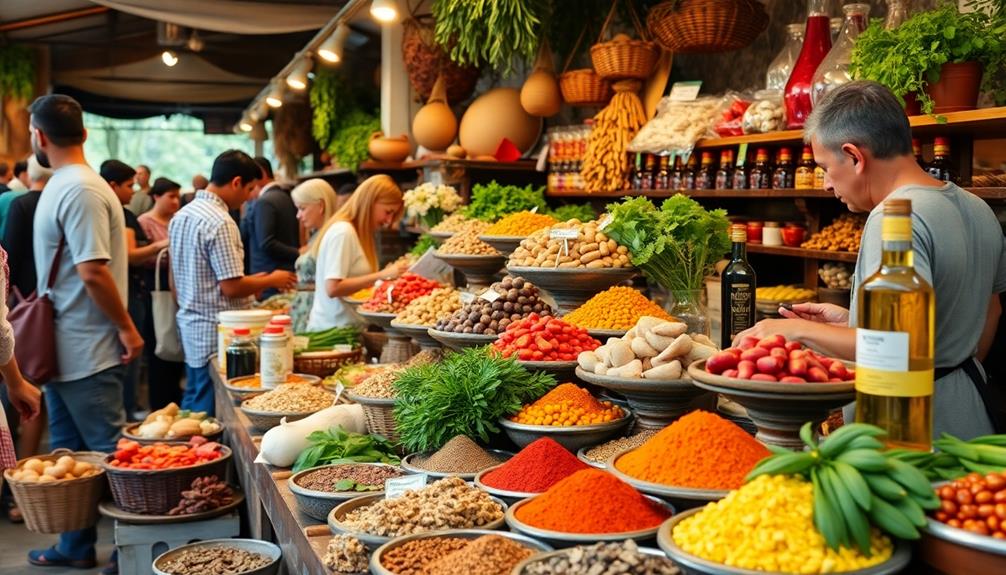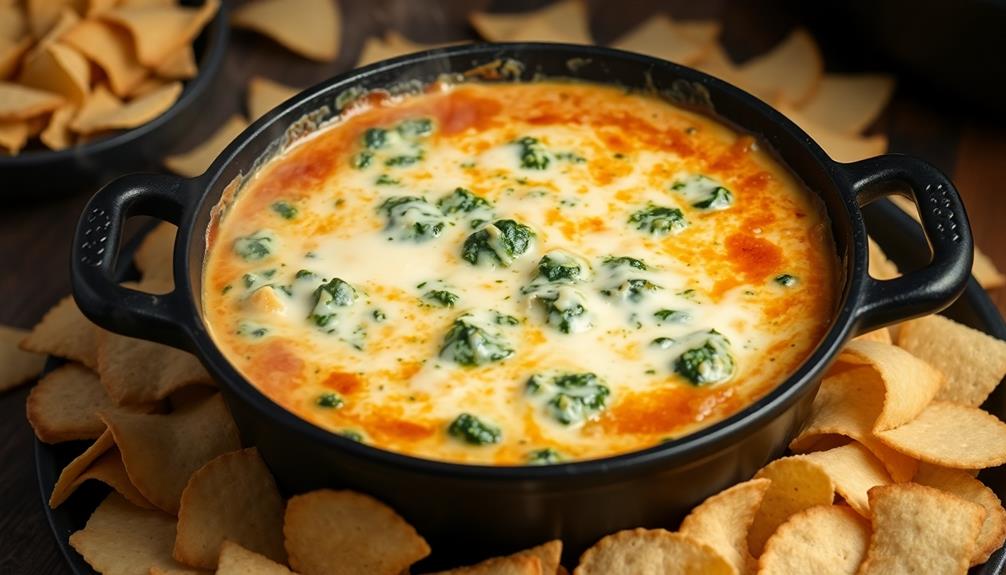Different cultures see food as a crucial aspect of health and healing. For instance, in Traditional Chinese Medicine, food balances Yin and Yang to enhance well-being. Ayurveda emphasizes fresh and seasonal ingredients to promote balance and health. In Unani medicine, dietary practices focus on maintaining the harmony of bodily humors. Many cultures infuse their culinary traditions with medicinal purposes, such as using turmeric for inflammation. These approaches reflect deep-rooted beliefs about food's healing properties. By exploring these rich traditions, you can uncover more fascinating insights into the cultural significance of food as medicine.
Key Takeaways
- Traditional medicine systems like TCM and Ayurveda emphasize dietary therapy as essential for health and disease prevention.
- Cultural beliefs influence perceptions of food as medicine, with emotional connections enhancing the therapeutic value of traditional meals.
- Historical texts advocate for food's role in health, demonstrating a longstanding understanding of dietary therapies across cultures.
- The integration of food-medicine products in markets reflects growing interest, with varying acceptance influenced by cultural and regulatory factors.
- Future innovations focus on sustainable agricultural practices and tailored meals to strengthen the food-as-medicine movement.
Historical Roots of Food as Medicine
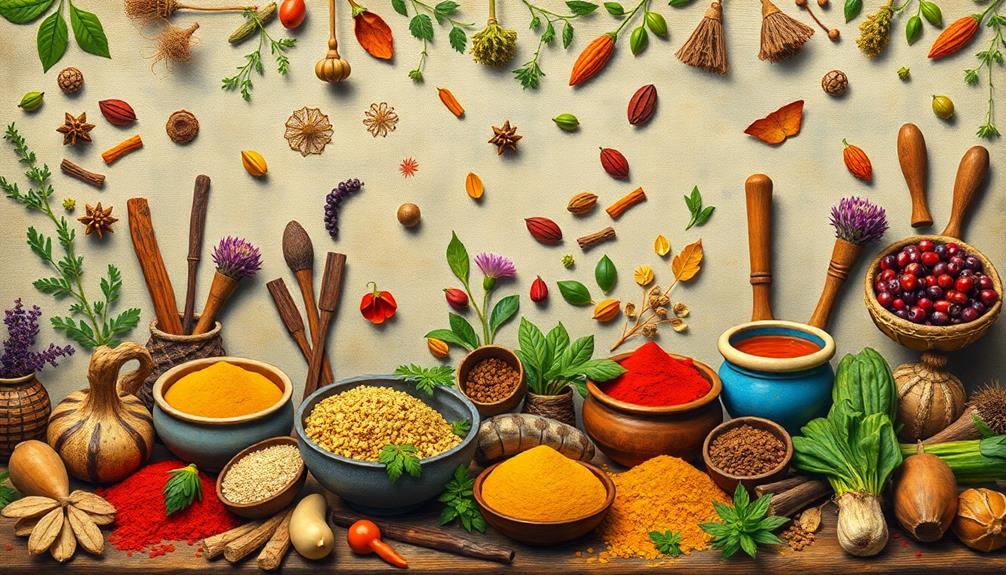
Throughout history, people have recognized the healing power of food, as evidenced by ancient texts like the Hippocratic Corpus and *Shiliao Bencao*, which advocate for dietary therapies. The concept of food as medicine isn't just a modern idea; it's deeply rooted in various cultures.
For instance, during the Han Dynasty, Zhongjing Zhang emphasized dietary therapy over medical interventions, a belief that continues in herbals like *Yinshan Zhenyao*. In South Asia, Ayurvedic texts like the *Charaka Samhita* also highlight the importance of food and diet in maintaining health, showcasing a rich tradition where food serves not just as sustenance but as a therapeutic agent.
This is reflected in popular dishes such as Mushroom Masala, which combines various spices to enhance health benefits alongside flavor. Historical documentation reveals specific foods utilized as remedies, such as the use of plant foods to treat Edward VI's tuberculosis, illustrating the medicinal properties of fruits and vegetables.
Across different cultures, the integration of food and traditional medicine reflects a shared understanding of health management. This longstanding tradition continues to influence modern nutritional perspectives, reminding you that what you eat can play a pivotal role in your overall well-being.
Traditional Medicine Systems

When exploring traditional medicine systems, you'll find that dietary therapy plays a significant role in practices like Traditional Chinese Medicine and Ayurveda. Each system emphasizes the importance of balancing various elements—whether it's Yin-Yang in TCM or the doshas in Ayurveda—to enhance health.
In Chinese cuisine, for example, dishes such as Red-Braised Pork Belly aren't only celebrated for their rich flavors but also for their ability to nourish the body.
Unani medicine also integrates dietary principles, focusing on the balance of bodily humors to promote overall well-being.
Dietary Therapy in TCM
Dietary therapy in Traditional Chinese Medicine (TCM) serves as a cornerstone for maintaining health and treating various ailments. In TCM, food is viewed not just as sustenance but as medicine that can influence your well-being. It emphasizes a holistic approach, integrating dietary therapy to manage conditions like hypertension and digestive disorders effectively.
Similar to how Brazilian cuisine incorporates diverse ingredients reflecting cultural influences, TCM also recognizes the importance of local and seasonal foods in promoting health diverse culinary influences.
TCM categorizes foods based on their properties—such as ascending, descending, floating, and sinking—as well as their tastes: pungent, sweet, sour, bitter, and salty. Each of these elements plays an essential role in their therapeutic effects on your body. The balance of Yin and Yang guides food choices, aiming to restore harmony and address both physical and emotional health.
You'll find that specific foods, like red yeast rice, can assist in managing cholesterol, showcasing how TCM blends dietary practices with herbal medicine.
Furthermore, TCM promotes preventive measures through personalized nutrition, tailoring dietary modifications to your individual constitution and seasonal changes. This approach reflects the deep-rooted belief in the power of food as medicine, emphasizing that what you eat can greatly impact your overall health.
Ayurvedic Food Practices
In Ayurveda, food is more than just nourishment; it's an essential tool for achieving balance and health. You'll find that traditional Ayurvedic food practices emphasize the importance of balancing the five properties—Rasa, Guna, Virya, Vipaka, and Karma—to tailor your diet according to your individual dosha, whether it's Vata, Pitta, or Kapha. This approach helps prevent and manage chronic diseases.
Incorporating ingredients that are rich in nutrients, such as fresh herbs and seasonal vegetables, can enhance your meals, much like how Farm-to-Table Cooking promotes the use of local produce for ideal health benefits.
The *Charaka Samhita*, a foundational Ayurvedic text, highlights the role of diet in promoting health, advocating for fresh, seasonal, and locally sourced foods. Incorporating a variety of tastes—sweet, sour, salty, bitter, pungent, and astringent—ensures you achieve balance and support overall well-being.
You'll also notice that traditional Ayurvedic practices frequently utilize medicinal plants like turmeric and ginger, known for their anti-inflammatory and digestive properties, enhancing the therapeutic effects of your meals.
Mindful eating is another key aspect; by being aware of your food choices and their impact on your physical and mental health, you cultivate a holistic approach to wellness. Embracing these principles can lead to a healthier, more balanced life.
Unani Medicine Principles
Ayurvedic practices highlight the importance of food in achieving health and balance, a concept echoed in Unani medicine. Unani medicine, rooted in ancient Greece, centers on the balance of the body's four humors—blood, phlegm, yellow bile, and black bile. Your diet plays an essential role in maintaining this balance, as food and medicine are deeply intertwined in this system.
For example, traditional dishes like Muamba De Galinha emphasize the use of nourishing ingredients, which can contribute to overall health and well-being.
Unani practitioners focus on natural remedies and dietary modifications tailored to your individual health needs. They emphasize the quality and preparation of food, recognizing that these factors greatly contribute to wellness. Foods are categorized based on their properties, such as hot/cold and wet/dry, guiding recommendations to correct imbalances in your humoral state.
Moreover, Unani medicine incorporates herbal medicines, with specific herbs prescribed for their medicinal properties in treating various ailments. This holistic approach integrates traditional beliefs and practices with modern medical knowledge.
As you explore Unani principles, you'll find an extensive framework that underscores the significance of diet in your overall health management, reminding you that what you eat can directly influence your well-being.
Cultural Practices and Beliefs
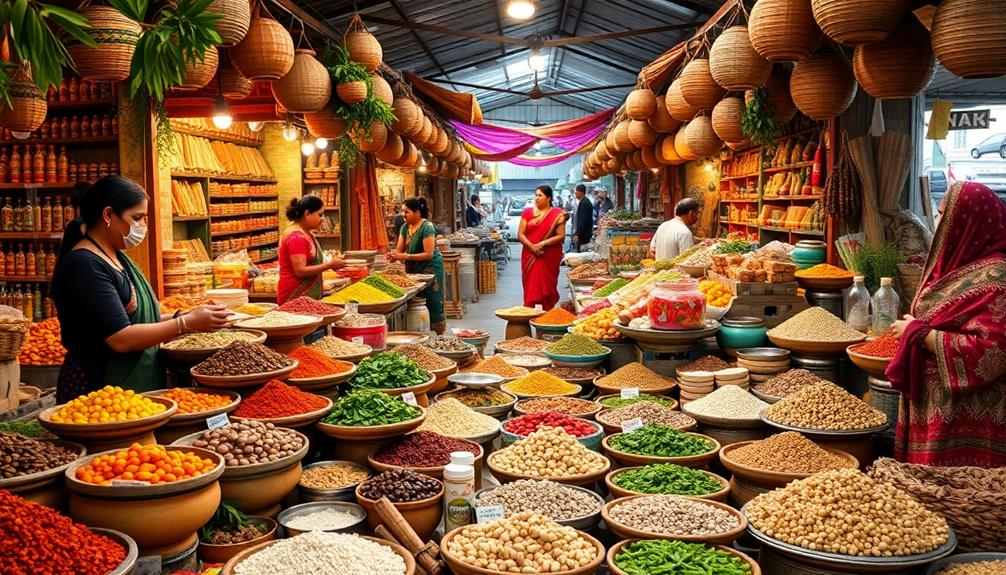
When you explore cultural practices and beliefs around food, you'll find that traditional healing methods shape how communities view dietary choices.
For instance, in Lebanese cuisine, dishes like Kawarma (Preserved Meat) aren't only enjoyed for their rich flavors but also for their historical significance in preserving food.
These practices reflect deep-seated values and beliefs, influencing what you consider healthy or comforting.
Understanding these perspectives can enhance your approach to food as medicine in your own life.
Traditional Healing Practices
Many traditional healing practices around the world emphasize the importance of food as a fundamental component of health and wellness. These practices, integral to the Food as Medicine Movement, recognize that what you eat can impact your well-being. For instance, in Ayurvedic practices, foods are tailored to individual dosha types, focusing on their Rasa (taste) and Guna (quality) to maintain balance.
Here's a snapshot of various traditional healing practices and their approaches to food:
| Healing Practice | Focus on Food |
|---|---|
| Traditional Chinese Medicine (TCM) | Balancing Yin and Yang for well-being. |
| Ayurvedic Practices | Dietary therapy based on individual doshas. |
| Ancient Greek Medicine | Therapeutic properties of food to restore balance. |
| Native American Healing | Using specific plants for diet-related diseases. |
| Unani Medicine | Balancing bodily humors through natural remedies. |
These approaches highlight the significance of Functional Foods in promoting health and treating ailments, showing that food is much more than just sustenance—it's an essential part of healing.
Dietary Beliefs and Values
Cultural beliefs and values greatly shape how different societies view food as medicine, influencing both dietary practices and health outcomes. You'll find that each culture's dietary beliefs reflect their unique understanding of health and wellness.
For instance, Traditional Chinese Medicine emphasizes the balance of Yin-Yang through food properties, while Ayurveda tailors nutrition to individual dosha types. In the Mediterranean, foods like garlic and olive oil are celebrated for their medicinal qualities. Similarly, in Japanese cuisine, dishes such as Dorayaki (Red Bean Pancake) bring comfort and joy, showcasing the emotional connections associated with food as medicine.
Consider these emotional connections to food as medicine:
- Comfort from a warm bowl of chicken soup during illness
- The sense of community shared over traditional meals
- The spiritual significance of using medicinal plants in Native American practices
- The holistic approach of Ayurveda, aligning food with personal health
- The joy of discovering the health benefits in diverse cuisines
These cultural values not only define what you eat but also how you perceive food as medicine. By understanding these dietary beliefs, you can appreciate the profound relationship between food, culture, and health, leading to more mindful choices in your own life.
Food-Medicine Products in Markets
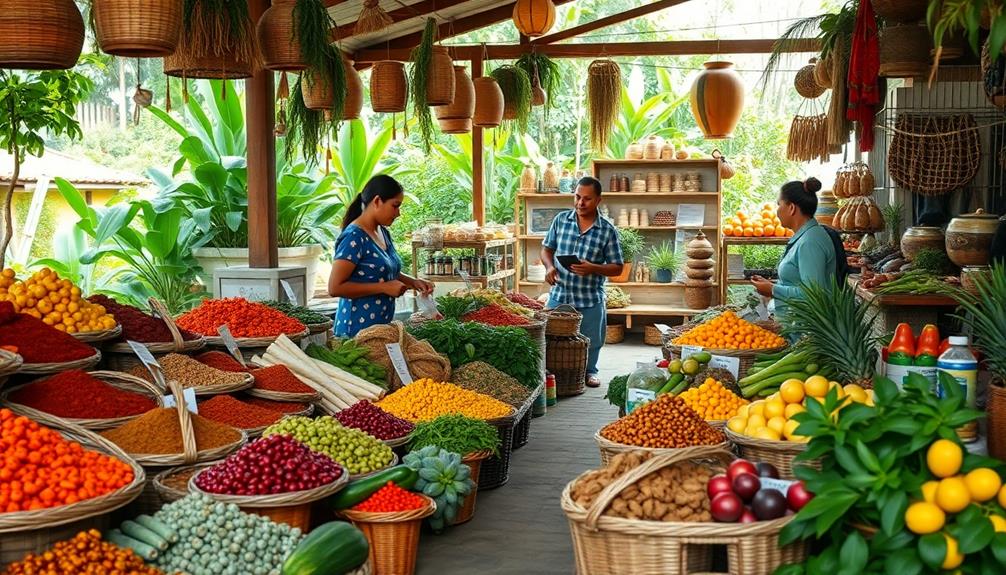
The market for food-medicine products is rapidly evolving, reflecting a growing interest in integrating health benefits into everyday diets. In China, you'll find 109 food-medicine dual-use entities and 151 species evaluated for their health benefits, showcasing how traditional remedies can become part of daily food practices.
For example, certain traditional Indonesian dishes like Kue Putu emphasize natural ingredients such as rice flour and coconut, highlighting how cultural foods can also offer health benefits. However, cultural differences impact the acceptance of these products. For instance, Europe recognizes only 37 species deemed significant for healthy food use, which limits the availability of traditional Chinese herbal products.
These cultural disparities influence how certain plants are perceived and utilized. Take Lonicera and Crataegus, for example; they've distinct applications in China compared to Europe. Knowledge transfer from traditional to modern practices has allowed products like goji berry and ginseng to gain traction in Western herbal medicine.
Yet, regulatory frameworks across regions, such as those in the European Union, Japan, and South Korea, create barriers for traditional remedies. These regulations can hinder the market's ability to fully embrace the potential of food-medicine dual-use products.
As you navigate this evolving landscape, understanding these differences and barriers will be essential for making informed choices about food as medicine.
Regulatory Challenges and Frameworks
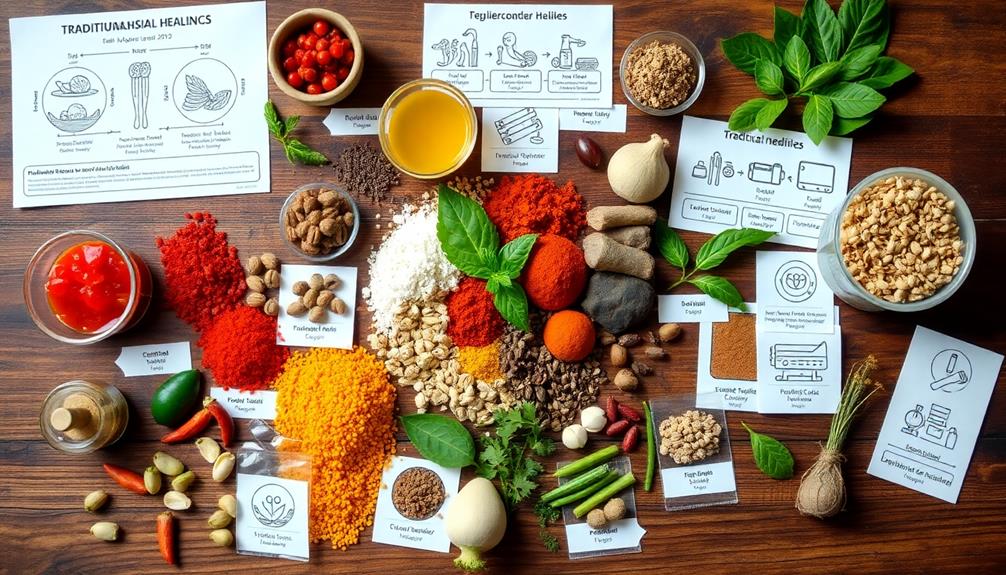
Maneuvering the landscape of food-medicine dual-use products requires an understanding of the regulatory challenges that vary by country. These challenges can make it tough for you to access beneficial traditional remedies, as differing regulatory frameworks create barriers to acceptance and integration into health practices.
For example, just as Chilaquiles represent the use of leftover tortillas in Mexican cuisine, many cultures have unique foods that hold medicinal properties yet face regulatory hurdles.
Consider these emotional impacts:
- Frustration over limited access to effective herbal remedies
- Confusion regarding the legality of traditional foods
- Anxiety about traversing complex regulations
- Disappointment when beneficial products are unavailable
- Hope for future collaboration between cultures
In China, the Food Safety Law categorizes substances into food, healthy food, and food-medicine categories. In contrast, Japan distinguishes between food with health claims and functional foods.
Meanwhile, Western markets impose strict regulations on many commonly used Chinese medicinal plants, limiting their acceptance. Only 37 species from a total of 109 food-medicine dual-use entities in China are recognized for healthy food use in Europe.
Understanding these frameworks is vital for promoting traditional herbal products globally, as ongoing research can bridge the gaps between Eastern and Western dietary therapies, fostering a more inclusive approach to health.
Future Directions and Innovations
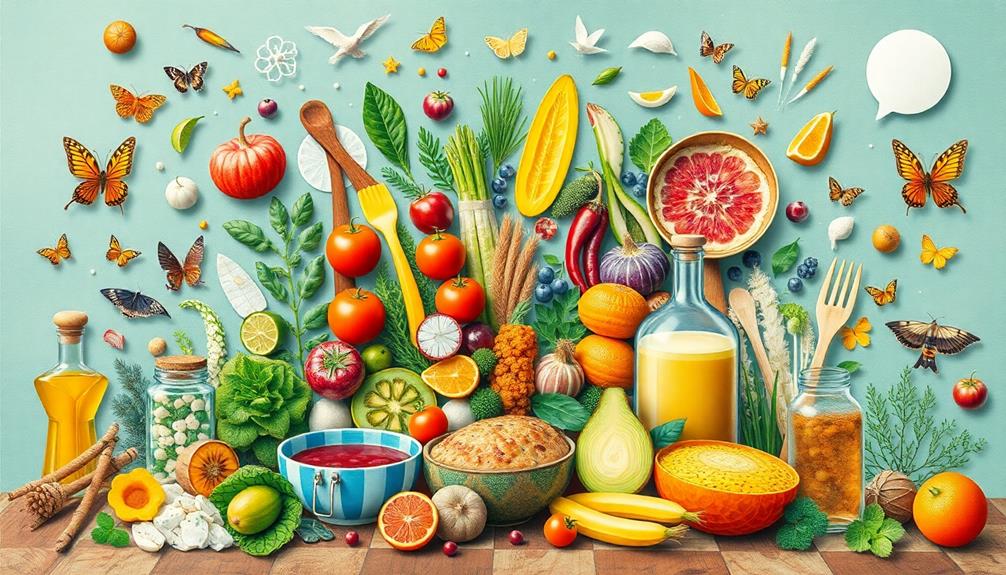
Innovations in the food-as-medicine movement are reshaping how we think about health and nutrition. As you explore this evolving landscape, you'll notice a growing emphasis on integrative approaches that connect agricultural practices with health outcomes.
Sustainable farming plays an important role in enhancing nutrient density in foods, making them more effective as treatment options. For instance, traditional Italian dishes like agnolotti, made with fresh, local ingredients, can be both nutritious and a delightful way to incorporate healthful eating into daily life.
Medically tailored meals and produce prescriptions are gaining traction, with health insurance plans increasingly supporting these initiatives to improve health equity. This shift recognizes that access to nutritious foods is essential for everyone, particularly those in need.
Collaborative efforts between healthcare systems and local farmers further strengthen community food systems, ensuring that wholesome options are available.
Research into functional foods, like probiotics and fermented products, reveals their potential to prevent and manage chronic diseases. Additionally, technology is driving future innovations, with apps and platforms designed to raise awareness of food as medicine principles.
These tools encourage healthier dietary choices and promote diets like the Mediterranean diet, which has long been recognized for its health benefits. Embracing these advancements can transform your approach to modern medicine and nutrition.
Frequently Asked Questions
What Cultures Use Food as Medicine?
Many cultures, like Traditional Chinese, Ayurveda, and Mediterranean, use food as medicine. They emphasize balance, dietary therapy, and specific food properties to promote health and treat illnesses, showing how deeply food influences wellness across societies.
How Does Food Connect With Different Cultures?
Food's a vibrant tapestry, weaving stories of identity and heritage. When you savor a dish, you connect with traditions, customs, and beliefs that shape your culture, revealing a delicious narrative rich in history and meaning. Just as different foods tell stories of culture, so do different film genres. Just as a spicy curry may represent the boldness and vibrancy of a certain culture, an action-packed film can embody the thrill and excitement of another. Similarly, a comforting bowl of soup can symbolize the warmth and unity of a community, just as a heartwarming family film can encapsulate the values and traditions of a particular group. Both foods and film genres serve as expressions of culture and identity, offering a unique window into the rich diversity of human experience. This is why certain foods are often associated with specific film genres, as they both serve as a reflection of the values, beliefs, and traditions of a particular group. Just as a rich and indulgent dessert can represent the opulence and luxury of a society, a lavish period drama can showcase the elegance and sophistication of another. Similarly, a light and refreshing salad might mirror the simplicity and purity of a culture, just as a minimalist art-house film can capture the beauty and tranquility of a different community. Both food and film genres offer a profound insight into the diverse tapestry of human culture and identity, making them essential elements of our shared human experience.
How Can Food Be Used as Medicine?
You can use food as medicine by incorporating healing ingredients into your diet. Foods like garlic, ginger, and probiotics can boost your health, improve gut function, and promote overall well-being, helping you feel your best.
What Is the Food as Medicine Approach?
The food as medicine approach is revolutionary; it transforms your meals into powerful health allies. By choosing nutrient-dense foods, you manage and prevent health issues, ensuring your body thrives and feels its absolute best.
Conclusion
In exploring how different cultures approach food as medicine, you'll find that nearly 75% of the world's population relies on traditional medicine, much of it centered around food. This highlights the deep-rooted belief in the healing properties of what we eat. As you look to the future, consider how these diverse practices can inspire innovative health solutions. By embracing food as medicine, you can take an active role in your well-being and that of your community.
